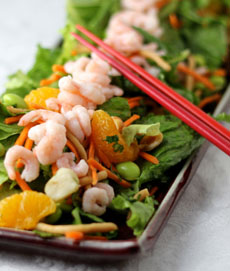TIP OF THE DAY: Chinese Chicken Salad
|
Since we were a mere tot, we’ve loved Chinese chicken salad. This American invention combines Asian ingredients into a delicious fusion.
There are variations on the name, but the rules are neither hard nor fast: “Mandarin” refers to the mandarin segments in the recipe. Chinese Chicken Salad uses mandarin or pineapple plus fried chow mein noodles. Thai chicken salad substitutes rice noodles (shown in the photo) for the chow mein noodles. Asian chicken salad, the most generic term, indicates a sesame-soy-ginger vinaigrette or peanut dressing. We recently had this “Mandarin” chicken salad at Cafe SFA, the restaurant in Saks Fifth Avenue in New York City. It’s easy to whip up. Using fresh mandarin segments instead of canned makes a huge difference, as does fresh ginger instead of powdered ginger in the dressing. If you don’t like ginger or peanut dressing, use plain vinaigrette of rice vinegar and vegetable oil, with a touch of sesame oil (taste it—some varieties are very strong, others are on the light side). RECIPE: MANDARIN CHICKEN SALAD Ingredients |

They call it Mandarin; we call it Thai because of the rice noodles and peanut dressing. Photo courtesy Café SFA. |
|
|
Ingredients 1. PLACE all ingredients in a blender and blend on high. |
||
 This variation, from Bullock’s tea room in Sherman Oaks, California, substitutes shrimp for chicken. Photo courtesy SweetAndCrumbly.com. |
RECIPE #2: PEANUT DRESSING
Ingredients 1. PLACE all ingredients in a blender and blend on high. Stovetop toasting: In a large frying pan, heat the sesame seeds over medium heat, shaking the pan occasionally. They are ready when they darken and become fragrant, 3 to 5 minutes. Oven toasting: Preheat the oven to 325°F. Spread the seeds on a baking sheet and bake until the seeds darken and become fragrant, about 15 minutes. Allow the toasted seeds to cool; then store in a covered jar at room temperature. |
|
|
THE HISTORY OF MANDARIN CHICKEN SALAD Raw salads are not traditional fare in Asia; Chinese salads are typically made of parboiled or stir-fried vegetables. There are different types of cold chicken salads, mostly from Szechwan, such as pong pong (or bong bong) chicken: shredded chicken and bean sprouts dressed with a peanut butter, red pepper and garlic sauce. We checked our favorite source, FoodTimeline.org, for the scoop on the emergence of the Asian/Chinese/Mandarin/Thai chicken salads we know and love today. According to American food historian Sylvia Lovegren, Chinese ingredient-inspired salads and dressings originated by the 1930s. But these early “Oriental” salads were nowhere close to what’s on menus today. One recipe circa 1923 consisted of diced prunes, dates, figs, chopped nuts, diced pineapple topped with “one cup salad dressing,” a vinaigrette or spiced mayonnaise. The “modern” recipe seems to have been introduced in California, and was made popular at Johnny Kan’s restaurant in San Francisco, a Cantonese restaurant that opened in 1953 (and is still operating). It combined shredded iceberg lettuce, strips of cold roast chicken and crispy chow mein noodles, fried noodles made from a combination of wheat and rice flours. The salad was tossed with a slightly sweet sesame oil-tinged dressing with flecks of hot red peppers or pepper flakes. The Asian-inspired salads that we know today evolved in the mid-1960s, adding more ingredients (mandarin segments, pineapple, vegetables) and more complex dressings, including the popular ginger-soy-sesame and peanut recipes. Asian-style salad dressings—soy sauce, ginger and sesame oil—were promoted in the 1980s as healthier alternatives to mayonnaise-based dressings for green salads. Thai flavors were introduced in the 1990s, with the growing popularity of Thai cuisine. Recent additions include edamame, borrowed from Japanese cuisine. Play around with it and create your own signature Asian salad. It will generate a huge demand!
|
||


